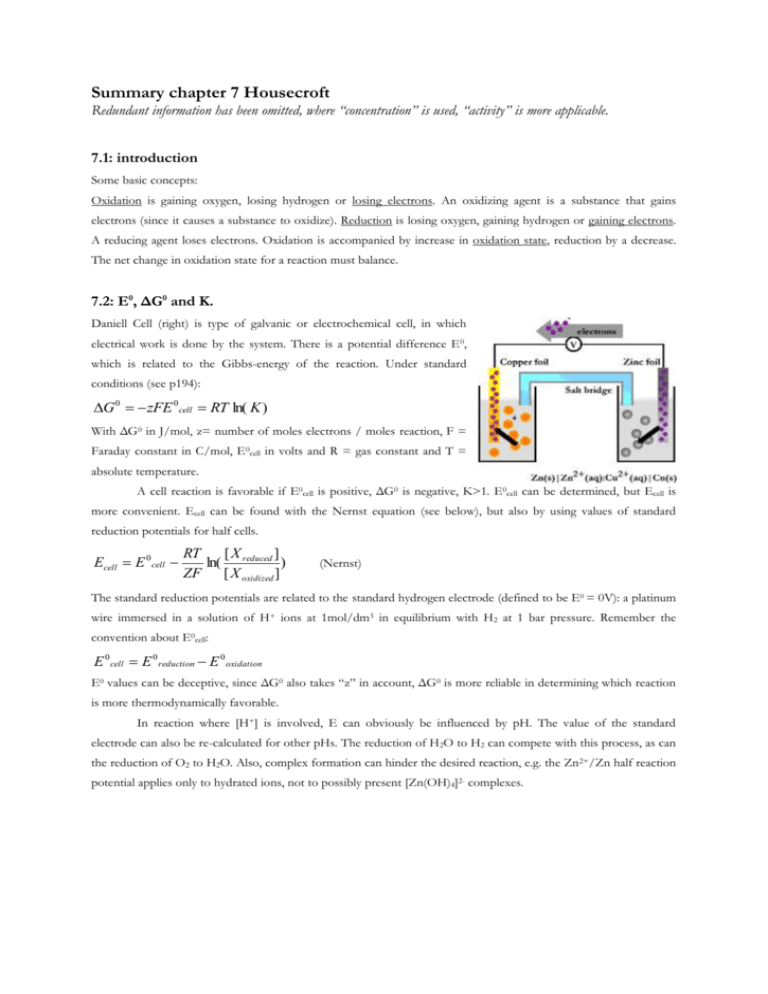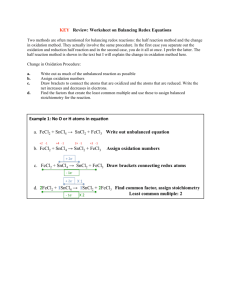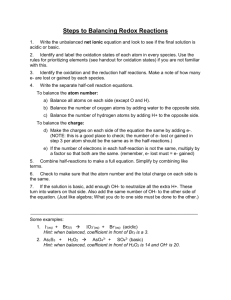Summary chapter 7 Housecroft
advertisement

Summary chapter 7 Housecroft Redundant information has been omitted, where “concentration” is used, “activity” is more applicable. 7.1: introduction Some basic concepts: Oxidation is gaining oxygen, losing hydrogen or losing electrons. An oxidizing agent is a substance that gains electrons (since it causes a substance to oxidize). Reduction is losing oxygen, gaining hydrogen or gaining electrons. A reducing agent loses electrons. Oxidation is accompanied by increase in oxidation state, reduction by a decrease. The net change in oxidation state for a reaction must balance. 7.2: E0, ΔG0 and K. Daniell Cell (right) is type of galvanic or electrochemical cell, in which electrical work is done by the system. There is a potential difference E 0, which is related to the Gibbs-energy of the reaction. Under standard conditions (see p194): G 0 zFE 0 cell RT ln( K ) With ΔG0 in J/mol, z= number of moles electrons / moles reaction, F = Faraday constant in C/mol, E0cell in volts and R = gas constant and T = absolute temperature. A cell reaction is favorable if E0cell is positive, ΔG0 is negative, K>1. E0cell can be determined, but Ecell is more convenient. Ecell can be found with the Nernst equation (see below), but also by using values of standard reduction potentials for half cells. Ecell E 0 cell [X ] RT ln( reduced ) ZF [ X oxidized ] (Nernst) The standard reduction potentials are related to the standard hydrogen electrode (defined to be E0 = 0V): a platinum wire immersed in a solution of H+ ions at 1mol/dm3 in equilibrium with H2 at 1 bar pressure. Remember the convention about E0cell: E 0 cell E 0 reduction E 0 oxidation E0 values can be deceptive, since ΔG0 also takes “z” in account, ΔG0 is more reliable in determining which reaction is more thermodynamically favorable. In reaction where [H+] is involved, E can obviously be influenced by pH. The value of the standard electrode can also be re-calculated for other pHs. The reduction of H2O to H2 can compete with this process, as can the reduction of O2 to H2O. Also, complex formation can hinder the desired reaction, e.g. the Zn 2+/Zn half reaction potential applies only to hydrated ions, not to possibly present [Zn(OH)4]2- complexes. An example of a redox reaction Mn(OH)3(s) + e- ↔ MN(OH)2(s) + [OH-](aq) E0[OH-=1] = +0.18V O2(g) + 2H2O(l) + 4e- ↔ 4[OH-](aq) E0[OH-=1] = +0.40V O2(g) + 4H+(aq) + 4e- ↔ 2H2O(l) E0 = +1.23V Mn3+(aq)+e- ↔ Mn2+(aq) E0 = +1.54V A reaction takes place between the most powerful redox couple (if one can be found), the reaction with the highest voltage is favored, and the reaction with the lowest voltage occurs backwards. In this example the reaction only occurs if OH- is present in 1M concentration. 4x Mn(OH)3(s) + e- ↔ MN(OH)2(s) + [OH-](aq) E0[OH-=1] = +0.18V O2(g) + 2H2O(l) + 4e- ↔ 4[OH-](aq) E0[OH-=1] = +0.40V 4MN(OH)2(s) + 2H2O(l) + 4[OH-](aq) + O2(g) + ↔ 4e- 4Mn(OH)3(s) + 4e- + 4[OH- ](aq) + 0.40V – 0.18V = 0.22V Thus: 4MN(OH)2(s) + O2(g) + 2H2O(l) ↔ 4Mn(OH)3(s) 0.22V ΔG0 = -(4· 96485 · 0.22) = -85kJ / mole reaction; or -21kJ / mole Mn(OH)2 Omitted: other methods for E0 determination (p195), overpotential (p195). 7.3: Complex formation and precipitation. The ΔG0 of a reaction depends on the concentrations of the involved species, the concentration can of course also change during the reaction, e.g. by complex formation or precipitation. Metals in higher oxidation states are more stable with respect to reduction in alkaline solutions than in acidic solutions. This is because hydroxides (OH-) of metals in higher oxidation states precipitate in alkaline solutions (see also “An example of a redox reaction”), thus driving the reaction. This also applies for other ligands: higher oxidation states are more stabile, also when keeping the same number of ligands: [Fe(CN)6]3-(aq) + e- → [Fe(CN)6]4-(aq) E0=+0.36V 7.4: Disproportionation reactions. Some redox reactions involve disproportionation reactions: 2Cu+(aq) ↔ Cu2+(aq) + Cu(s) 3[MnO4]2-(aq) + 4H+(aq) ↔ 2[MnO4]-(aq) + [MnO2](s) + 2H2O(l) Can also be concluded from redox table, by combining the different redox reactions involving these species. 7.5: Potential diagrams. To find out how species (e.g. [MnO4]- vs MnO2(s)) are present in solutions, one can look at the different E0 values of the involved half reactions. These data can be represented as potential diagrams, also known as Latimer diagrams, or via Frost-Ebsworth diagrams (see next section). In the Latimer diagram species are placed from left to right in order of decreasing oxidation state, and E0 values are displayed. These E0 values should be calculated from the half-reactions using ΔG0 to account for the differences in numbers of electrons. 7.6: Frost-Ebsworth diagrams. Frost-Ebsworth diagrams are a graphical representation of the stability of different oxidation states. -ΔG0 or -ΔG0/F values are plotted against N (the oxidation state). Bear in mind that -ΔG0/F = zE0. A Frost-Ebsworth diagram can be constructed from the matching Latimer diagram, this is done by step-by-step calculation of the next value, with the first set at 0, e.g. E0 for Mn to Mn2+ is 2.38V, and from Mn2+ to Mn3+ the E0 is 1.54V: -ΔG0/F = zE0 = 1 · 1.54, and -2.38 + 1.54 = -0.84 → Mn3+ = -0.84V. Some conclusions that can be drawn from the diagram: - The lowest point in the diagram represents the most (thermodynamically) stabile state. - Species towards the top-right of the diagram are strong oxidizers. - Contrary to Latimer diagrams, values here can be added. - In Housecroft Frost-Ebsworth diagrams going from left to right represents oxidation, and the accompanying E 0 can be calculated. E.g.: Mn(s) ↔ Mn2+(aq) + 2e-, thus E0 = E0red – E0ox = zE0/z = -(-2.38/2) = 1.19V. - “Convex points” are points that lie above a line drawn between neighboring points, species on these points are unstable with respect to the neighboring species, and will thus disproportionate (see reaction figure). - Conversely, “concave points” (that lie below this line), are stabile with respect to disproportionation. 7.7: Standard reduction potentials and other quantities. Omitted: factors influencing the magnitudes of standard potentials, thermodynamic data, values of Δ fG0 7.8: Redox reactions in the extraction of elements from their ore. Omitted: Earth is oxidizing environment, Ellingham diagrams.






